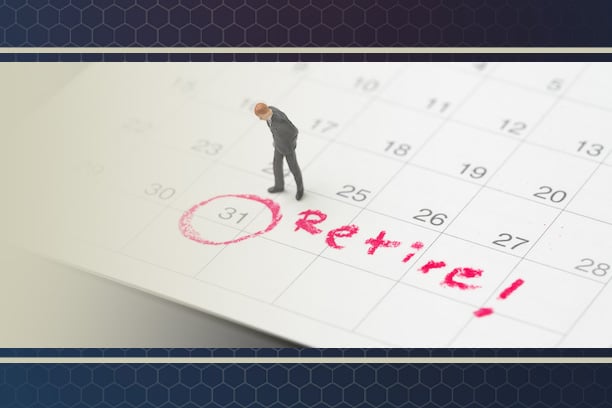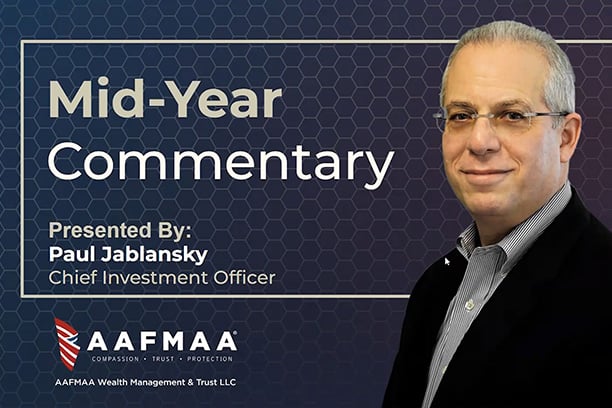

What You Need to Know About Managing Your Money after the Military
Presented: July 1, 2022
Transitioning from military to civilian life can impact almost every part of your finances, so how can you feel confident when making the shift? Join the discussion on the essential money-management tools you need to square away the present and plan for your future.
Transcript
June 2021 WOTM Script Josh Schnelle
What You Need to Know About Managing Your Money After the Military
Slide 1: Title (Kathleen)
Hi and welcome, this is Kathleen Lovito, and I will be your host for today’s webinar on managing your money after the military. Our presenter today is Josh Schnelle, Relationship Manager with AAFMAA Wealth Management & Trust. Before we begin, here’s a quick background on the company.
Slide 2: (Kathleen)
This webinar series is brought to you by AAFMAA Wealth Management & Trust. Our mission is to be the premier provider of financial planning, investment management, and trust services to the American Armed Forces Community. AAFMAA Wealth Management & Trust is a fully owned subsidiary of AAFMAA. AAFMAA, has proudly served America's Armed Forces since 1879. AAFMAA is a non-profit, tax-exempt (501[c] (23)), member-owned mutual aid association offering life insurance to all branches of the U.S. Armed Forces and their families.
Slide 3: (Kathleen)
Also, a few disclaimers: This presentation is educational. It is for general information only and is not specific investment, legal, or tax advice for any of you individually. Do not rely on this presentation alone to guide your investment management decisions. Since each situation is unique, your needs for financial services will differ. For individual advice, please contact us directly. We produce this webinar series in-house with our professional staff as a service to our members to help them better understand the resources that are available to them. We have highlighted here two distinct characteristics that separate AAFMAA Wealth Management & Trust from other service providers: [1] Our fiduciary standard, which requires us to always act in our clients’ best interests, and [2] we exclusively serve the U.S. Armed Forces Community.
Slide 4: (Kathleen)
[Turns presentation over to Josh]
Slide 5: Agenda
As a military veteran, I know that transitioning to civilian life involves many decisions and creates different emotions ranging from excitement to stress.
Fortunately for you, many people have gone through this before and we can learn from their experience and share our financial knowledge to help you make a plan for managing your finances throughout your transition.
Today I will address several personal finance topics, and make recommendations on specific action items to prioritize.
You have a lot on your plate as you transition, and this webinar should provide you with a process for addressing your financial future, and offer you some practical tips to help you address these important topics.
Slide 6: Experience as Your Guide
According to Einstein, “The only source of knowledge is experience.” So today I want to share knowledge gained through others' experience so you can learn best practices.
According to research, 48% of veterans said their transition was more difficult than expected, while 76% agree that their transition was stressful.
https://www.military-transition.org/graphics.html
You have a lot going on as you transition (I know I did when I made the shift from active duty to civilian) and it is very likely that your transition will be harder than you expected, so at some point you will put something on the backburner. Do not let it be managing and planning your personal finances. It bleeds into so many other areas of your life and needs to remain a priority.
Surveys have indicated that 73% of Americans rank finances as the number one stress in their lives. Transitioning is already a stressful period for you and your family. Having a great handle on your personal finances can help alleviate some of that stress, and hopefully make your transition a much more enjoyable process.
https://www.cnbc.com/select/73-percent-of-americans-rank-finances-as-the-number-one-stress-in-life/
Slide 7: Agenda
Now, before we get into specific financial areas to address, I'd like to offer two broad suggestions: First, envision your future, then second, create a plan to get there.
Slide 8: Envision Your Future
Envision Your Future: Before we can really understand what plans need to be put in place, you need to take the time to really think about what you want your future to look like.
Slide 9: Envision Your Future
If you are planning on a second career after the military, what type of work will you pursue? Slide 10: Envision Your Future
Will that require additional education? How long do you plan to work in this second career? Slide 11: Envision Your Future
And after you fully retire what are the specific things you see yourself doing? Slide 12: Envision Your Future
Where do you plan to live? Is that cost of living comparable to where you are today? Slide 13: Envision Your Future
What specific things do you want to do with your time? Fishing?
Slide 14: Envision Your Future
Golfing?
Slide 15: Envision Your Future
Traveling? Or building a remote cabin?
Slide 16: Agenda
Envisioning your future is such an important step because you cannot accurately plan for your future without a picture of where you are trying to go. Your specific goals and circumstances will affect how you tackle the next step, which is to plan.
Slide 17: Create a Plan to Get There
You may be surprised to hear that many Americans do not spend much time on retirement planning. In fact, on average only 11% of Americans spend as much time on retirement planning as they do vacation planning!
A vacation may last a week, or possibly longer if you're lucky, while retirement will probably last 20 years or more. Which one do you think you should devote more time to planning?
And in addition to retirement there are many more financial areas to be planning for, which also have a significant impact on your life. In fact there are a few areas we will cover first that are important to take care of before you ever start planning for retirement.
You probably already know this, but diligent planning takes time and effort. But believe me, it is a worthwhile effort, because the hour or two you put into planning each month can make an enormous impact on not only YOUR future but your family's future as well. Long-term success in almost every endeavor can be linked back to planning and that’s especially true in your financial life. Today we will discuss key areas to plan in order to set you yourself up for success.
So, as we dive into planning for that future you have envisioned after the military, we are going to look at ways to plan for protecting your near-term future and then talk about ways to plan for your long-term future. Both are areas you need to be especially focused on during your transition, as some choices cannot be undone. Let's start with addressing the foundation: protecting today.
When I was in the Army I served as an Air Defender. If you happen to be an Air Defender you are sure to remember our motto: “First to Fire.” As a strategic defense around the globe one of our objectives was to protect the U.S. and our allies’ interest against a first attack so our follow-on forces could come in, and subsequently win, the fight.
We were there to protect today so other military assets could win tomorrow, and the subsequent long-term future. How does that translate to personal finance? Well what good does it do your family if you have a 30-year savings plan you are executing but then you have an unexpected death two months into your plan, without any life insurance? How long would your family be financially okay without you? Would they be able to stay on track for the long-term?
This is only one example of the need to protect your present. I know that a lot of the time we focus on setting big goals for our future, which is great. I am a huge believer in setting big long-term goals, which is part of the envision step we already discussed. However, too often we forget to prepare for near-term events that could derail our long-term plans by first planning for “what-if” scenarios. One of my favorite quotes by Eleanor Roosevelt is “Yesterday is history, tomorrow is a mystery, and today is a gift––that is why it is called the present.” Let’s review a few key steps to properly protect you and your family as your step away from some of the military benefits that you may currently have in place.
Slide 18: Emergency Fund
Having an emergency fund is a foundational step in personal finance. It keeps you from needing to use high-interest debt, which leads to long-term financial struggles. If you have a
transmission go out, your kid has a trip to the ER, or you get laid-off, do you have an emergency fund to prevent you from using debt?
According to a 2018 Report on the Economic Well-Being of U.S. Households, about 39% of Americans could not cover a $400 unexpected expense without going into debt. It is typically recommended to maintain 3-6 months’ worth of non-discretionary expenses. If your household has two or more sources of income, then 3 months’ worth is sufficient. If your household has one source of income, then 6 months’ worth of expenses is suggested. Non-discretionary expenses are those that do not go away if you lose your job. However, if you are transitioning to the civilian world from military service you have more uncertainty than most other times in your life. Many veterans experience employment gaps of more than 3 months after transition. And any of the benefits you may be expecting, whether VA disability, or a military pension, can take much longer than expected to actually make it to your pocket. Due to this uncertainty I recommend 9-12 months of non-discretionary expenses set aside. Once you settle into your new life after the military, that amount can be reduced to 3-6 months.
Also, having a defined budget helps you know how much your non-discretionary expenses are, so this is something I recommend doing now. There are some great tools for budgeting I’m going to cover later.
If you do not have an emergency fund you need to immediately start building one. Even if you can only save $50/month, start there and then try to add more when you have excess income until you reach your emergency fund goal. This takes discipline and may mean you cut something from your monthly expenses until you get this foundational goal accomplished.
Slide 19: Insurance
Another foundational topic is your insurance coverage. I know insurance is not a fun thing to talk about but it is critical to protect you and your loved ones. And I know a lot of people have had a negative experience with an insurance salesman. I think we all have. That is why it is very important to get an insurance analysis from someone who is objective and is a fiduciary . A fiduciary is someone who is legally bound to provide you with recommendations that are in your best interest. Anytime you are seeking financial advice ask if the financial professional is a fiduciary.
Here at AWM&T we do an insurance analysis as a part of your financial plan. We evaluate your overall situation and goals and then recommend a specific amount of insurance coverage. We then recommend you go seek quotes from three different companies.
We are not compensated for any insurance you purchase, which helps you know we are only recommending what’s best for you. That is important when you are trying to decide what the right coverage is for you.
Let's talk about a few things to know about life insurance.
When you separate from the military it is critical to review your life insurance options because some options are limited to a certain period after your service. You are eligible to convert your SGLI to VGLI without a medical screening as long as you make the change within 240 days of separation. Many times you can get a better rate with a different life insurance provider if you
are in good health so it is recommended to apply for those coverages before your 240 days are up. If your health screening comes back with good results you can most likely opt for something other than VGLI and save some money.
However, If your health screening has a negative impact on your insurance cost then you can opt for the VGLI without a medical exam. Another decision to make is whether you need term or permanent life insurance. Most basic explanation I can give is that Term will expire at a set date in the future, usually 10/20/30 years later, and is therefore cheaper than permanent life insurance which will never expire and in some cases can grow a cash value benefit.
Your specific circumstances will determine how much protection to get and which option is best for you. However, a rule of thumb is a Death benefit of 10–16 times your annual gross pay. Your spouse should also have enough life insurance on themselves to cover the loss of their contributions to your family’s income and responsibilities, regardless of their employment status. Lastly, I do want to remind you that life insurance really isn't for you, it is for your family. An insurance analysis can help you understand the specific amount needed to cover debt, and living expenses for a certain period of time so your family is taken care of if something unexpected happens to you. This is an area that needs attention immediately because the impact of not having adequate life insurance can be catastrophic.
Life insurance is there to protect your family if you have a premature death, while disability is here to protect you and your family if an accident or illness prevents you from being able to work and earn an income. Unlike life insurance's lump sum payment, disability insurance will replace a portion of your income each month if you meet the disability qualifications. Most of us think this won't happen to us, but the truth is that 1 in 4 20-year-olds become disabled before retirement. There are two main types of private disability insurance: short-term and long-term. The main difference is the benefit period. Short-term coverage typically gives you a benefit for 3-6 months, while long-term benefits can range from 2 years all the way until retirement age.
There are different options for the amount of coverage you would like, such as replacing 50% of your current income, and then you can also choose if it covers loss of income from only your current occupation or any occupation. For example if you have "own occupation" disability insurance and you are a medical doctor, then any disability that prevents you from performing your functions as a medical doctor would allow you to receive benefits.
On the other hand, if your coverage was for “any occupation” then the disability would have to prevent you from receiving compensation from any occupation you are qualified for based on education, experience and age, before you would qualify for benefits. Sometimes the coverage
will allow your benefits to fill the gap between what you were earning before the disability and what you are now earning after the disability.
The cost varies based on your type of occupation, the length of coverage, the % of income replacement you select, as well as a few other factors. As you can see a lot goes into this decision, so seeking advice from a trusted professional can add a lot of value. Ideally, that trusted financial professional is helping you evaluate your options as a part of your complete financial plan, so you can see what is most appropriate for your overall needs, goals, and budget.
Additionally, there is a benefit available from the government for long-term disability. In 2019 the average disability payment was just over $1,200/month which would barely be over the poverty level. To receive disability benefits from the SSA, a person must meet the definition of disability under the Social Security Act (Act). A person is disabled under the Act if they can't work due to
a severe medical condition that has lasted, or is expected to last, at least one year or result in death. The person's medical condition(s) must prevent them from doing work that they did in the past, and it must prevent them from adjusting to other work.
https://www.ssa.gov/disabilityfacts/facts.html
Long-Term Care - In my opinion LTC insurance is probably the most underrated insurance coverage that exists. Most people cannot visualize a day when they will need LTC coverage. When they reach an age where they start to see LTC may be needed in their future the coverage is often no longer affordable. Most people who do seek LTC coverage have experienced taking care of a loved one who needed LTC and then were able to understand how impactful coverage can be.
We learned from the AWM&T LTC webinar in February that 70% of people will need LTC in their lifetime. If you would like to check out that LTC webinar, as well as others we have done in the past, go to AAFMAA.com, resources, then webinars.
So, if 70% of people will need LTC in their lifetime, then it really is more a question of WHEN not IF. Having a VA disability rating does not automatically disqualify you from LTC coverage and it really depends on your specific health situation. However, if you do not qualify for traditional LTC insurance there are some alternatives that may work for you. Sometimes permanent life insurance has a benefit that allows you to take some of your death benefit each year if you encounter a LTC event. This is another reason to be looking at your plan as a whole so you can see where some areas of coverage may overlap.
Slide 20: Health Coverage
There are so many options out there for medical coverage that we could spend hours on this subject. What is important to recognize during your transition is that many of these health benefits were free while you were serving in the military so you need to plan ahead on where you will seek your health coverage and include those costs in your new budget.
If your new employer offers coverage in these areas, spend time evaluating your options as the decisions you make can have a significant impact on your finances. Don't be afraid to ask questions when onboarding and seek help from a professional financial planner if you need it, especially one who understands military income and lifestyle.
For the health coverage section I want to focus on what a Health Savings Account or Flexible Spending Account are. They are both ways to save for medical expenses before your income is taxed.
To be eligible for an HSA Your health coverage has to be considered a High Deductible Health Plan. You can then contribute pre-tax dollars into your HSA. Sometimes employers will have a match on your contributions to an HSA, making it even more appealing. Then in the future, if you use those HSA funds for medical expenses they remain tax-free. Those funds also roll-over each year and after a certain dollar amount saved they can start to be invested for long-term growth. The growth within the HSA is also tax-free. This allows for triple tax savings. Your money goes in tax-free, grows tax-free, and comes out tax-free if used for medical expenses. It doesn't get much better than that when looking at tax savings.
Also an HSA can also act as a tax-deferred retirement savings vehicle. Once you turn 65 you can use your HSA to pay for things other than medical expenses, you will just be required to pay income tax on your withdrawal, in the same way you would your IRA, if the funds aren't used for medical expenses.
Flexible Spending Account- The main difference in an FSA and HSA is the FSA is it is a “use it or lose it” benefit each year, so there really is no long-term growth potential with an FSA, but still may be a great tax savings strategy if an HSA is not available to you. You can put money away pre-tax and use it in the same year to cover medical expenses.
Slide 21: Stress Test
All of the areas we have talked about for protecting the near term should be evaluated to see how it will affect your overall plan for meeting your goals. If you are seeking professional help with developing a financial plan to address all of these topics, make sure they are able to stress test your current situation for these different events. These stress tests will be able to give you a clear picture of how different events would impact your goals and will give an objective view at areas you can improve upon.
Slide 22: Invest in Your Future
That leads me right into the next stage of planning. After you have addressed ways to be prepared in the short-term it is time to address ways to plan for your near, mid- and long-term goals.
As mentioned earlier, envisioning and discussing your long-term goals is key in helping you determine how much to save and how to save it. However, if you don't have a specific goal in mind you can still work on saving now because at some point in the future I am sure you will have goals that require funding.
Slide 23: Budget and Track
As a part of your near-term planning you should already have a cash flow analysis in place, also known as a budget.
As you shift your focus into long-term planning it is important to continue tracking your in-flows and outflows. There are some fantastic tools out there that you can securely link your accounts to and allow their software to track your expenses.
I have used Mint.com for many years and love it. You can create a budget within the app and set alerts for when you have gone over a certain area. Some other popular budgeting and tracking apps that do similar things are You Need a Budget (YNAB), and Personal Capital. We also have our own budgeting and tracking portal you can use through our Financial Dashboard.
If you don’t budget now, or have what we call a cash flow analysis, it can be hard to get yourself to start. Your mindset around budgeting can make all the difference in success and failure. Many people think of a budget as restricting them and so they avoid it. However, you can shift that mindset and think of a budget as giving you permission to spend money on things you like and want without having to feel guilty or anxious. If you already know your budget is covering your essentials, and your budget allocates $100 for shopping you have given yourself permission to go spend that money. Remember, your budget should include your planned savings and investments as essential "expenses"." Those should not just be left to whatever is remaining at the end of the month. Setting up automatic savings is one of the best ways to accomplish that goal. We are naturally inclined to take the path of least resistance. That’s why we sign up for subscriptions and then forget to cancel them because they are on auto-pilot. Turn that into a positive thing by putting your savings on autopilot. That can apply to all the different areas you are trying to save.
Slide 24: Investments
This is the section most of you were waiting for, how to make money. It is the topic most people want to talk about when it comes to financial planning, and I too want you to do well with your investments, but it is only one piece of the puzzle when it comes to having a well-thought out financial plan. As you transition there are several topics you should address first before coming to this topic, and we have already addressed those. So, let’s talk about a winning investment strategy.
A winning investment strategy is not going to be some flashy, exciting, get-rich-quick strategy. Quite the opposite really. A sound, long-term, investment strategy needs to be a methodical,
consistent, boring strategy where you consistently invest every month into a diversified portfolio based on fundamental investment analysis. It should not be based on the hype that is currently on Reddit or Discord, or from your high school buddy who knows you should invest everything you own into this one new amazing company!
Your investments are set up to help you get to your mid-term and long-term goals. No matter what the goal is, you want to have time on your side so start saving as soon as you can because compound interest is potentially one of the most powerful tools in growing your investments.
One common goal out there today is not outliving your money in retirement. That seems like a pretty common sense objective, however, many people are surprised at how much they actually need to have saved to fully fund their retirement.
No matter where you are saving for retirement, we see the best approach is consistent, long-term investing. Again one of the best ways to do this is through automatic investments. If your employer offers a retirement plan, you can elect to contribute a portion of your paycheck before it ever reaches your bank account and tempts you to spend it elsewhere.
Another question I get asked alot, how much should you be saving for retirement? Well an exact answer is dependent on your goals and how much you have already saved but there are benchmarks to use as a rule of thumb. A benchmark savings ratio target is 10-12% of annual gross income if an individual begins saving before age 32; if you wait until after age 32, the amount moves to 12-15%; and if you wait until age 45 or 50, the rate increases to 15-20%.
To calculate your annual savings ratio, add your employee and employer contributions (including profit sharing) and divide that total by your annual gross income. If your employer does not offer a retirement plan, there are other ways to achieve tax advantaged retirement savings, such as saving in an IRA or Roth IRA and you can set up automatic contributions to those as well.
What's the overall theme here? Invest consistently and early to take advantage of your most powerful tool: compound interest. Let's take a look at some practical examples of that approach.
Slide 25: Investments
Here are three real-world scenarios that show the power of early, consistent saving. (Describe examples.)
Slide 26: Comprehensive Financial Planning
Although there is an order of priority when planning, when possible, creating a comprehensive plan is most prudent. It allows you to look at all of the different pieces of your financial life, and helps you create a roadmap to your goals. And once the plan is created you should review it every one to two years to update your changes and see if you are still on track.
Slide 27: Summary
We have discussed a lot today in order to help you be better prepared for managing your money after your military transition. The key is to identify your priorities and take care of each one, one step at a time.
Slide 28: Agenda
Thank you for tuning in to learn more about how to manage your money after the military. Slide 30: Questions?
If you missed something during the webinar today or would like some additional clarification please reach out to any of our Relationship Managers who are here to make sure you have all the information you need during this vital time. We are here to answer your questions and would be happy to discuss your specific situation with you in greater detail.
Thanks so much for tuning in.
Slide 32/33: Disclosures






